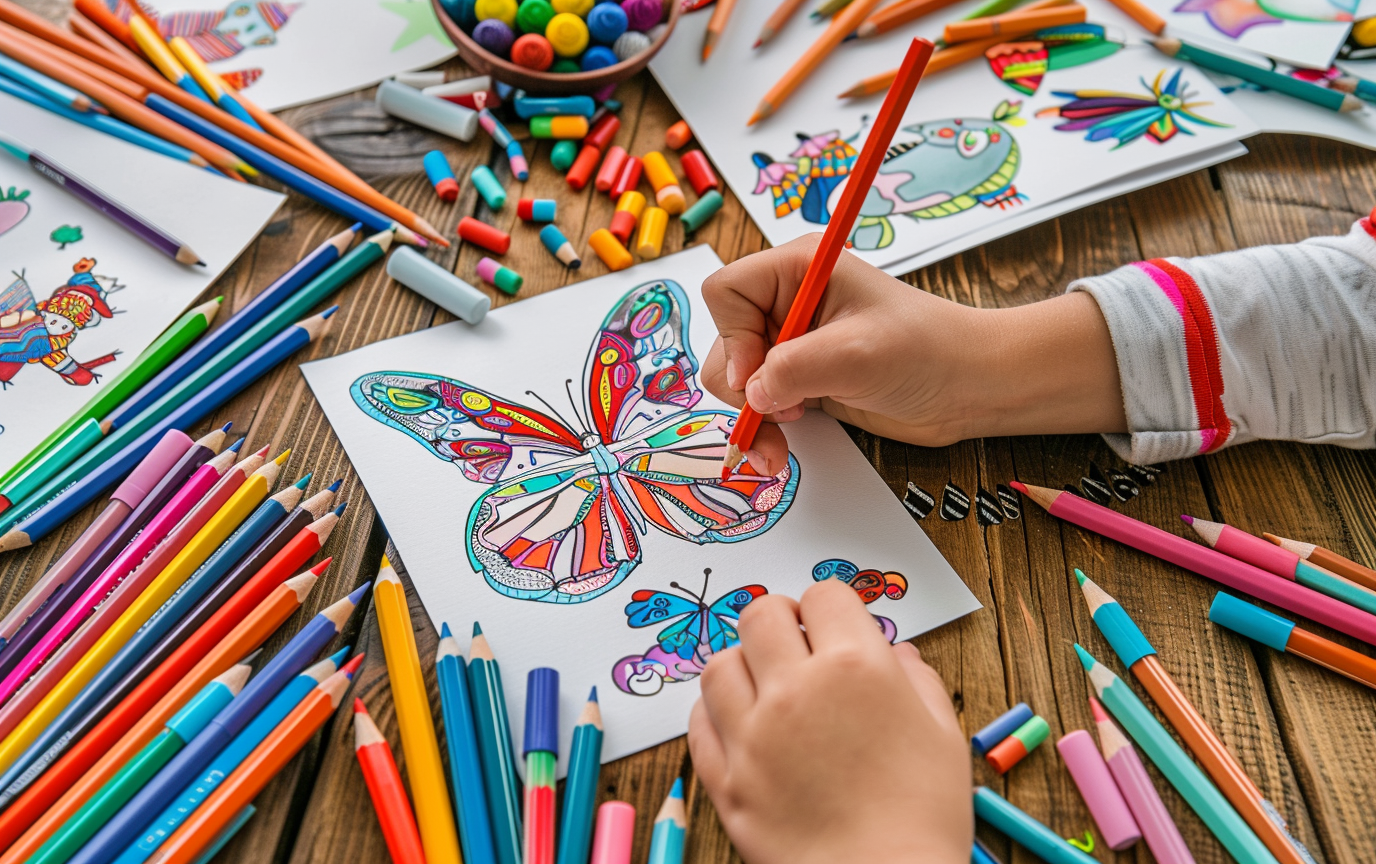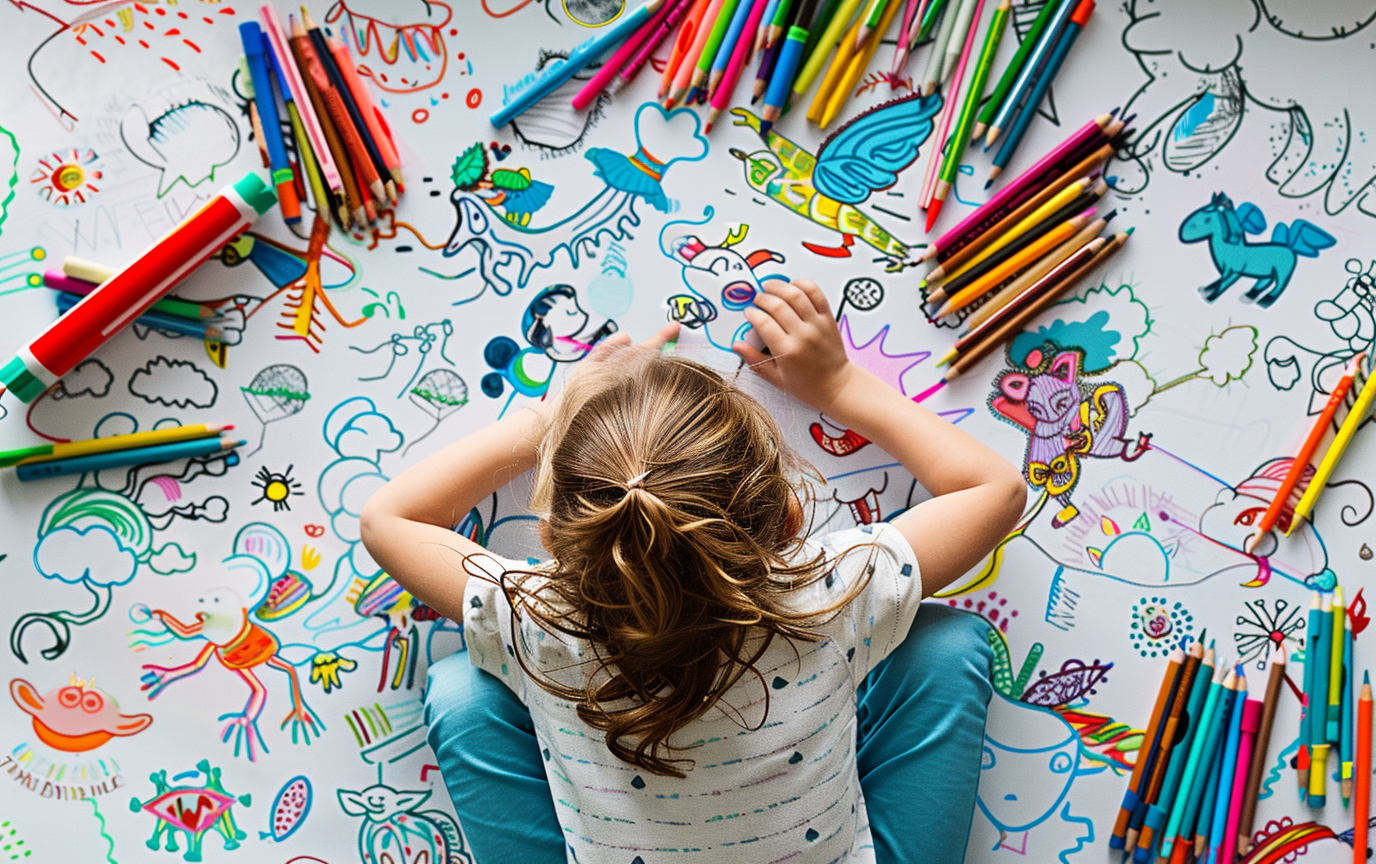Why Coloring Pages Help Kids Develop Focus and Creativity

Coloring pages are fantastic for helping kids develop focus and creativity. By choosing colors and staying within lines, Coloring Pages Help Kids sharpen their concentration and pay close attention to detail. These activities also boost fine motor skills and hand-eye coordination, which are essential for tasks like writing and using scissors. Coloring enhances color recognition, fostering imaginative thinking and decision-making. It’s a great way for kids to express themselves creatively, build patience, and develop perseverance through project completion. If you explore more, you’ll see even more ways coloring benefits children’s overall growth.
Key Takeaways – Coloring Pages Help Kids
Coloring pages enhance focus by requiring attention to detail and precision.
They improve concentration through sustained engagement in a single task.
Creative decision-making in color selection fosters imaginative thinking.
Coloring activities promote patience and perseverance through project completion.
Experimenting with colors encourages creative expression and emotional communication.
Enhances Concentration Skills

Coloring pages for kids significantly enhance concentration skills. When your child sits down with a coloring book, they’re not just filling in shapes with colors; they’re honing their focus and concentration skills. By carefully choosing colors and staying within the lines, children learn to concentrate on the task at hand. This activity naturally improves their attention span, a crucial aspect of children’s development. Explore our Printable Winter-Themed Coloring Pages to engage your child in fun, focus-building activities.
Moreover, coloring pages stimulate creativity. Your child gets to decide which colors to use, fostering decision-making and imaginative thinking. As they focus on their coloring, they immerse themselves in a world of creativity, which can be a wonderful stress relief.
Concentration skills developed through coloring pages also translate into better academic performance. When your child learns to focus on small details, they’re better equipped to handle more complex tasks in school. This quiet, focused activity encourages patience and persistence, qualities essential for lifelong learning.
Lastly, while doing coloring sheets, kids indirectly work on their fine motor skills, helping them control small muscles in their hands and fingers. This control is vital for tasks like writing and using scissors.
Improves Fine Motor Skills

Delicate hand movements play a crucial role in a child’s development, and coloring pages are an excellent way to improve fine motor skills. When your child picks up a crayon or colored pencil, they engage in activities that require precision and control. These actions help in mastering fine motor skills, which are essential for daily tasks.
Coloring activities not only improve motor skills but also build hand strength. As your child colors within the lines, they practice the fine control needed for other tasks, like tying shoelaces or using utensils. Over time, these activities also contribute to better handwriting. Holding and maneuvering the crayon strengthens the muscles in their hands, making it easier for them to write neatly and legibly.
Moreover, the benefits of coloring also helps children develop hand-eye coordination. The process of focusing on a specific area and filling it with color trains their eyes and hands to work together seamlessly. This skill is vital for numerous other activities, such as sports or playing musical instruments.
Boosts Hand-Eye Coordination

When your child engages in coloring, they’re doing more than just filling in spaces with bright hues—they’re actively boosting their hand-eye coordination. Each stroke they make on coloring pages requires them to precisely align their hand movements with what their eyes see. This practice fine-tunes their motor skills, making their coordination more accurate and efficient over time.
As children decide which areas to color and what colors to use, they employ creative thinking and problem-solving skills. They might choose a different approach for complex patterns versus simpler ones, which further enhances their ability to plan and execute tasks. This isn’t just about staying within the lines; it’s about making deliberate choices that improve their hand-eye coordination.
Additionally, drawing contributes significantly to this developmental process. When kids draw, they often switch between looking at their reference and their blank paper often, requiring quick, accurate adjustments of their hand movements. This oscillation sharpens their ability to coordinate their hands and eyes simultaneously.
In essence, coloring pages provide a fun, engaging way to spend time and for children to develop essential motor skills. By regularly practicing coloring and drawing, they not only boost their hand-eye coordination but also enhance their overall problem-solving abilities.
Encourages Color Recognition

A child’s early exposure to coloring pages can significantly enhance their ability to recognize and differentiate colors. By engaging with various hues, your child develops essential color recognition and becomes more aware of the world around them. This activity isn’t just fun; it’s a crucial part of their cognitive development.
As they choose and apply colors to create pictures, they start to understand color combinations, which fosters their learning and imagination. When your child picks up a crayon, they’re not just scribbling; they’re building skills that will help them in numerous ways. Selecting the right colors for different parts of a picture improves their decision-making abilities and enhances their color awareness.
Over time, they’ll become more adept at distinguishing subtle differences between shades, which is vital for various aspects of daily life. Coloring pages also encourage your child to experiment with different color combinations, sparking their creativity and expanding their cognitive horizons.
The simple act of using coloring books helps them associate colors with objects, ideas, and emotions, making their learning experience richer and more multi-dimensional. So, hand them a coloring book and watch their skills and imagination flourish.
Fosters Creative Expression

Coloring pages provide a fantastic outlet for fostering creative expression in children. When your child dives into the world of coloring, they’re not just filling in spaces; they’re engaging in self expression. By choosing colors and creating pictures, your child can communicate their thoughts new ideas and emotions without saying a word. This fun activity allows them to explore their imagination and develop a deeper understanding of their preferences and artistic style.
As they color, they’re also improving motor skills. The act of holding crayons or colored pencils and staying within the lines enhances their hand-eye coordination and fine motor abilities. You as parents might notice that your child becomes more adept at tasks requiring precision, such as writing or using scissors.
Coloring can also be a wonderful family bonding experience. When family members sit down to color together, it strengthens relationships and provides an opportunity for shared creativity. You can learn a lot about your child’s personality, feelings and interests by observing their choices and the stories they create through their artwork.
Ultimately, coloring pages are more than just a pastime; they’re a powerful tool for nurturing your child’s creative expression and overall development.
Builds Patience and Perseverance

In addition to fostering creative expression, engaging with coloring pages also builds patience and perseverance in children. When kids sit down with a coloring page, they embark on a task that requires sustained focus. It’s not just about filling in spaces with colors; it’s about completing a project from start to finish. This process helps kids develop patience as they wait to see their vision come to life.
Perseverance comes into play when they face challenges, such as choosing the right colors or staying within the lines. Kids learn problem-solving skills as they figure out how to navigate these small obstacles. The act of coloring teaches them that some tasks take time and effort, reinforcing the importance of sticking with something even when it’s difficult.
Moreover, this activity encourages creativity and boosts their developmental and social skills too. By repeatedly practicing patience and perseverance, kids not only improve their ability to focus but also build a foundation for handling more complex tasks in the future.
Coloring pages, therefore, are more than just a fun pastime; they’re a valuable tool in a child’s overall growth and development.
Summary
Coloring pages aren’t just fun; they’re powerful tools for your child’s development. By engaging in this simple activity, your child enhances concentration, improves fine motor skills, and boosts hand-eye coordination. They’ll also learn color recognition and foster their creative expression. Plus, coloring builds patience and perseverance. So, the next time your child reaches for their coloring book, know that they’re doing much more than creating art—they’re developing crucial skills for their future.
Frequently Asked Questions
How Can Parents Encourage Children to Engage More With Coloring Activities?
You can encourage children to engage more with coloring activities by providing a variety of interesting coloring books, setting aside dedicated coloring time, and have adults joining them in the activity to make it a fun, shared experience.
Are There Specific Types of Coloring Pages That Are More Beneficial for Kids?
Yes, you can choose intricate designs of animals, scenes from stories, or themed pages that align with your child’s interests. These types of pages can keep them more engaged and encourage creativity and attention to detail.
At What Age Should Children Start Using Coloring Pages for Development?
You should introduce coloring pages to children as early as 2 years old. At this young age, they can start developing fine motor skills and creativity. Just ensure the pages are simple and suitable for their developmental stage.
How Often Should Children Engage in Coloring Activities for Optimal Benefits?
You should encourage children to engage in coloring activities daily for optimal benefits. Even just 15-30 minutes of coloring sessions each day can significantly enhance their focus and creativity while providing a fun, relaxing experience.
Can Digital Coloring Apps Provide the Same Benefits as Traditional Coloring Pages?
Digital coloring apps can provide many benefits, similar to those of traditional coloring pages. You’ll find that both methods enhance a child’s focus and creativity, though the tactile experience of paper might offer additional sensory benefits.



